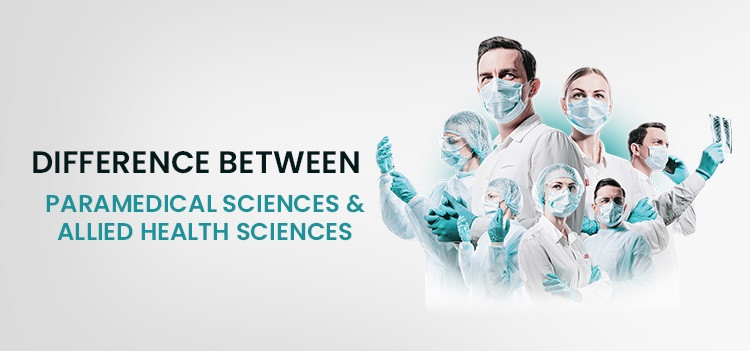Paramedical Sciences and Allied Health Sciences are two major streams in the field of medicine. Both are directly and indirectly related in treating patients in the field of health care. But many confuse that both paramedical sciences and allied health sciences are the same, but in reality, they are slightly different. The paramedical sciences basically give the outline paramedical knowledge while allied health sciences gives the in-depth understanding of the subject and concepts.
Let’s try to differentiate between paramedical sciences & Allied Health Sciences
Paramedical Sciences
The Paramedical sciences is one of the fields of medical science that basically deals with non-invasive medical treatments. The Paramedical science covers a wide range of different subject sciences related to medical care. The paramedical sciences mainly focus on actual physical procedures where others focus on theory and anatomy but their common goal is to take care of a patient.
The paramedics are highly trained medical practitioners, who are required to take the life-saving decisions under pressure at ease during difficult and emergency situations. The paramedical sciences basically combine the social skills with vast medical knowledge with a unique ability. The paramedics are the ones who always work under pressure especially in a medical emergency. The decisions taken by the paramedics are very crucial and can be life saving ones.
Some of the paramedical courses are:
- Diploma in Medical Laboratory Technology (DMLT)
- Diploma in Operation Theatre Technology & Anaesthesia Technology (DOT & AT)
- Diploma in Health Inspector (DHI)
- Diploma in Ophthalmic Technology (DOT)
- Diploma in Medical Records Technology (DMRT)
- Diploma in Medical Imaging Technology (DMIT)
Allied Health Sciences
The Allied health sciences is the group of many paramedical science courses. The subjects under allied health science are more when compared to the paramedical sciences. The allied health sciences gives a detailed understanding of different paramedical courses. The paramedical courses are limited to diplomas while the allied health sciences has both bachelor’s and master’s degrees.
The allied health sciences use the scientific principles and evidence-based practice for the diagnosis, evaluation and treatment of acute and chronic diseases and treat them. The allied health sciences has been gaining a lot of importance in the last 5 to 10 years, the demand for the skilled allied health science professionals is booming across the globe. The allied health science professionals are required to assist the MBBS doctors across the globe. This has created a spurring demand for skilled professionals.
The students with bachelor's degree with different subjects such as perfusion technology, respiratory technology, renal dialysis technology, etc are required in hospitals and clinics all across the world.
Some of the courses under Allied Health Sciences are:
- B.Sc Perfusion Technology
- B.Sc Anaesthesia and Operation Theatre Technology
- B.Sc Medical Imaging Technology (MIT)
- B.Sc Renal Dialysis
- B.Sc Optometry
- B.Sc Medical Laboratory Technology (MLT)
- B.Sc Cardiac Care
- B.Sc Neuroscience
- B.Sc Respiratory Therapy
- B.Sc Radiation Technology
- M.Sc Perfusion Technology
- M.Sc Medical Laboratory Technology (MLT)
Difference between Paramedical & Allied Health Sciences
Both the courses are equally important in their own stream, the paramedical courses are largely limited to diploma courses, while the allied health sciences have both bachelor and master’s degrees. The experts from the education sector especially in the medical field are advising the students to take up paramedical sciences and allied health sciences to explore the untapped opportunities in the field of medical science across the globe.
Syllabus for Paramedical Science & Allied Health Sciences
Both Paramedical Sciences and Allied Health Sciences sound the same, there are some differences between the courses. The paramedical courses will basically deal with basic concepts and techniques, while the allied health sciences focuses more on deeper study and detailed understanding of the concepts.
|
Paramedical Sciences |
Allied Health Sciences |
|
Anatomy and Physiology |
Applied Pathology |
|
Laboratory Procedures & Quality Management |
Applied Anatomy & Physiology related to Cardiac Perfusion Technology |
|
Radiographic Procedures |
Cardiac Care Technology- Clinical & Applied |
|
Basic Pathology |
Neuroanatomy |
|
Fundamental Biochemistry |
Molecular Biology and Neurogenetics Personality Theories |
|
Overview of Kidneys Functioning |
Life Support Systems-I & II |
Career Prospects after Paramedical & Allied Health Sciences
There are ample career opportunities for both paramedical students and allied health science students. Both professionals are highly in demand in both India and abroad.
The paramedical diploma students can continue their detailed study by joining various allied health sciences courses such as B.Sc Perfusion technology, B.Sc Renal Dialysis, B.Sc Cardiac Care etc.
The allied health science students can continue to study Master’s courses that are relevant to their degree, like M.Sc Perfusion Technology, M.Sc MLT etc.
In both the cases the opportunities are more and salaries are also better for skilled paramedical and allied health sciences professionals.
On an average a paramedical diploma student can easily earn from around 2 Lakhs to 4.5 Lakhs PA. While the salaries are better in case of allied health sciences, the average salaries will be around 4 Lakhs to 8 Lakhs PA.
Conclusion
The demand for both the streams is increasing day by day, the present trend in allied health sciences and paramedical sciences continues to grow in the future. There will be more opportunities available in the future especially in paramedical and allied health sciences when compared to conventional medical fields.

